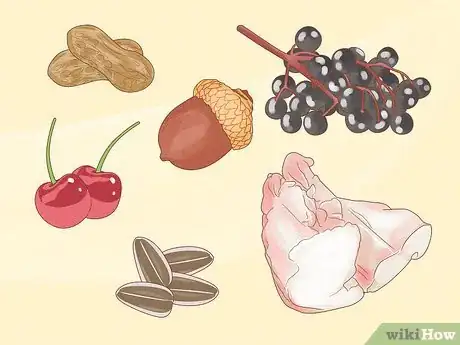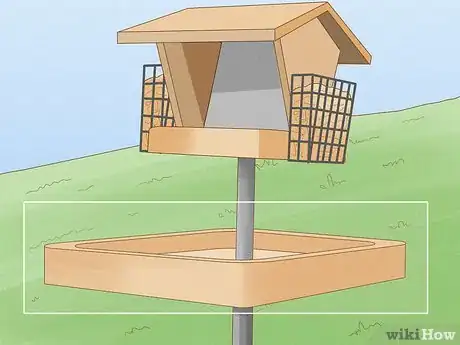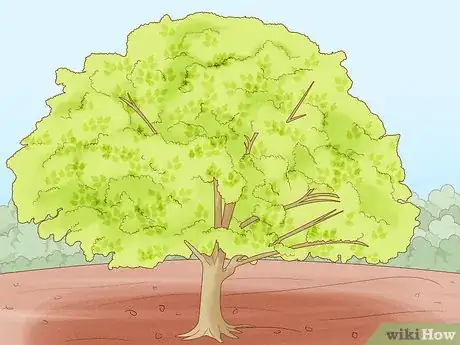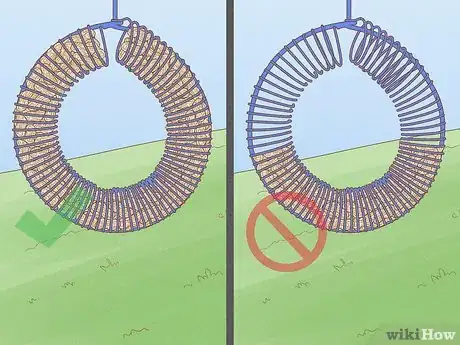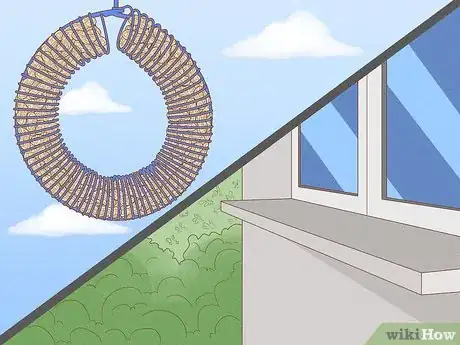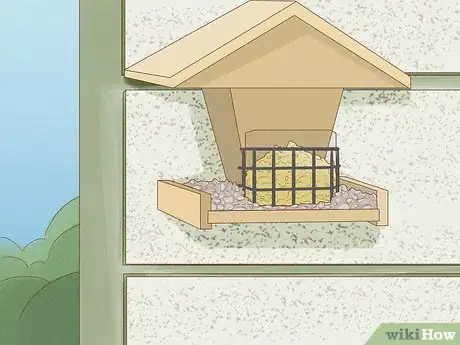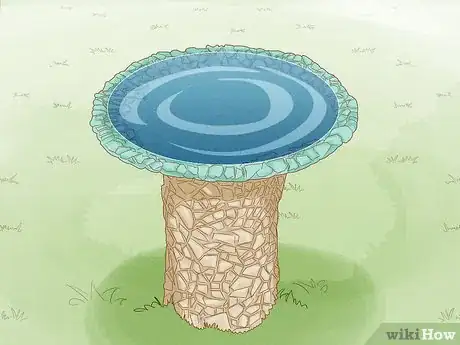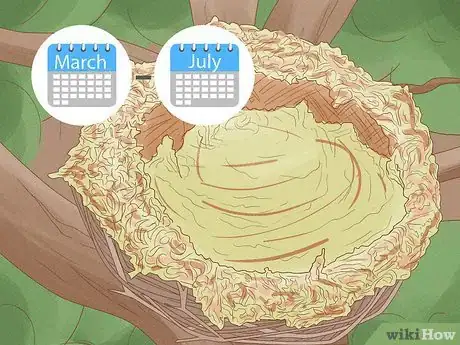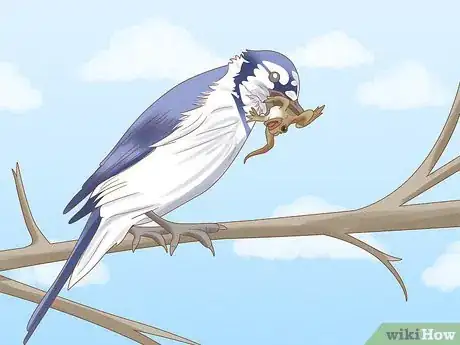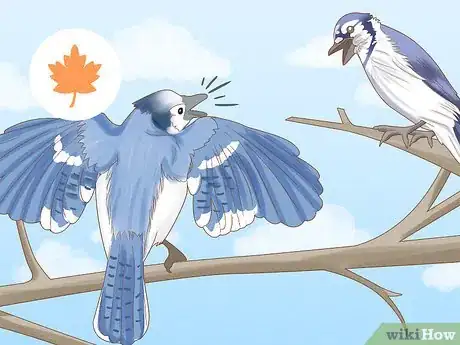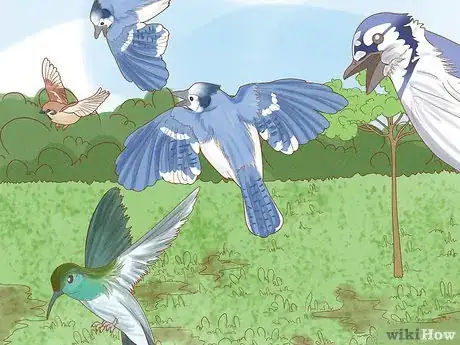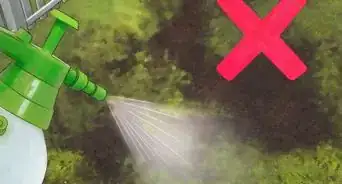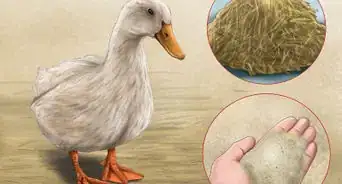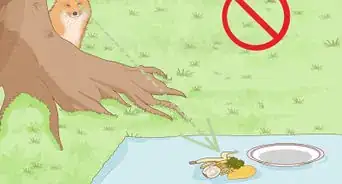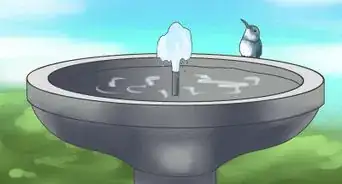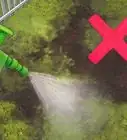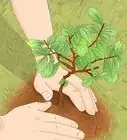This article was co-authored by Roger J. Lederer, PhD. Dr. Roger Lederer is an Ornithologist and the founder of Ornithology.com, an informative website about wild birds. Dr. Lederer has spent over 40 years teaching, studying, and writing about birds. He has traveled to over 100 countries to study birds. Dr. Lederer is an Emeritus Professor of Biological Sciences at California State University, Chico, and has been a Department Chair of Biological Sciences and Dean of the College of Natural Sciences. He has written more than 30 research papers and 10 books on birds and a textbook entitled “Ecology and Field Biology.” Dr. Lederer has consulted the BBC, National Geographic, National Public Radio, ABC News, the Guinness Book of World Records, and numerous other organizations and publications.
wikiHow marks an article as reader-approved once it receives enough positive feedback. In this case, 100% of readers who voted found the article helpful, earning it our reader-approved status.
This article has been viewed 231,705 times.
Blue Jays can be beneficial for the environment due to their proclivity of "planting" seeds and acorns. This, in turn, populates the environment with foliage. Today, you can find Blue Jays in just about any habitat in the eastern half of the United States, although they prefer oak woodlands. While they can be a bit raucous, they will add a beautiful vibrant pop of color to any yard or scene.
Steps
Feeding Blue Jays
-
1Offer the Blue Jays their favorite foods. The best way to attract birds to your area is with food. The Blue Jay's diet mainly consists of plants, vegetables and nuts, though they also eat some insects. You will draw quite a few Blue Jays to your area if you offer a variety in a large platform feeder. Some of the Blue Jay's favorites include:
- Peanuts (preferably shelled)
- Black and striped sunflower seeds
- Elderberries
- Cherries
- Dogwood
- Acorns
- Suet
-
2Keep their perch clear. Make sure the feeding area that you offer the jays has plenty of perching available. You want a nice, large, open shelf – not an enclosed area. If you notice it’s covered in food or that part is inaccessible due to an obstacle of sorts (like a branch), adjust the shelf to make it easier for the birds to munch. If you really care about them you can clean off the sides of the house.
- You should clean up any left over berries, nut shells, egg shells, feces or dead insects on the bird perch or house to keep it clean.
Advertisement -
3Consider planting an oak tree. Blue Jays prefer oak woodlands, though they can be found just about anywhere. However, if you want the best odds of getting Blue Jays, oak is the way to go.
- Beech trees are a solid second as they too have nuts Blue Jays love feasting on.
- What’s more, having trees around will provide the Blue Jays shelter should they need it from inclement weather (which is especially important in winter). It’s good for nesting, too.
-
4Keep the food stocked. Blue Jays are some of the most intelligent birds out there and, in general, have great memories. If you only stock food intermittently, they'll likely find somewhere else to go that's more reliable. Keep the peanuts coming and you'll be logged into their brains as a good, consistent food source.[1]
- Blue Jays are generally quick to move. If the food disappears, they won't likely wait for it to show up. To keep the same ones around, you'll need to be on top of your Blue Jay game.
Building a Blue Jay House
-
1Build or purchase an open nesting platform. Blue Jays are attracted to flat spaces on tree branches or surfaces like window sills. For this reason, they will make good use of a flat nesting platform instead of a traditional house.
- The floor area should be no less than 8 inches (20 cm) by 8 inches (20 cm). It should be high off the ground, either mounted in a tree or on a pole. Whatever platform location you choose, make sure it is not prone to predators such as raccoons. Blue Jays can build their nests anywhere from 5 feet (1.5 meters) to 50 feet (15 meters) above ground.[2]
- You can also buy hanging feeders, like peanut wreaths, that are especially designed to attract birds like Blue Jays. You can also try a fun craft if you have kids or make it alone. Take a pinecone and cover it with peanut butter and bird seeds. Birds go crazy for them and you can sometimes find these things right in your very own home.
- Hanging feeders are more free-floating, making it harder for other animals like raccoons to get at. However, they are more unstable and larger birds may shy away from them.
-
2Choose a place that’s in the shade and away from predators. Have your nesting platform inaccessible to squirrels if at all possible. Since you’ll likely be loading the platform up with nuts and seeds, it could be a squirrel’s heyday – and he could fight off the birds from his new-found treasure.
- In the shade is important, too. Sometimes Blue Jays will eat and eat and then stock up food in their mouths (their gular pocket) to bring back to their home and bury for later. This can take a lot of time, and if they’re in the sun, they’ll heat up. Keep your feeders in the shade so they can stay comfortable.
-
3Install a birdbath. A birdbath a good source of water for the jays and a good source of entertainment for you as you watch them bathe. A birdbath will also attract birds of other varieties, too.[3]
- Having a birdbath with a light mister or small fountain is double the fun. The birds will be intrigued, and you’ll be intrigued watching the birds’ fascination with their find.
Understanding Blue Jays’ Habits
-
1Be aware of the Blue Jays' mating and nesting habits. Blue Jays mate from March to July and this must be taken into consideration when building or installing your nesting platform. You should anticipate when the mating pair needs the nesting platform so you can have it up and ready to go. Blue Jays are monogamous and will normally stay together until one dies.
- It might also help if you offer a pile of sticks and twigs nearby to help them with building their nest. The efforts to build a nest can take hundreds of trips back and forth bringing in the needed materials. Providing them these items encourages them to remain in the area.
-
2Know that Blue Jays are omnivorous. For the most part, Blue Jays eat nuts and seeds, yes. But they have been known to harvest on eggs or even small frogs, baby birds, and invertebrates from time to time. You may catch a bird in the act of something you’d rather not see. It’s important to know this before you go about hoping for Blue Jays in your area.
- Because of this, many people are actually in the market to get rid of the Blue Jays in their yard, believing the Blue Jays are wreaking havoc on the other animals that are more peaceful. It's important to consider this side before you have a yard full of them.
-
3Be aware that they can be a bit raucous. They tend to move around in groups, especially in the autumn, and their social behavior can be quite dynamic.[4] They can be obnoxious, too, scaring away other birds and even imitating hawks to do so. They’re highly territorial – but if they’re outnumbered, they’ll back off. Because of their antics, some people don’t like them in the garden or backyard, but they are quite the sight to see!
- Blue Jays are sort of a give and take. You may have to bequeath your yard unto them, but they will grace you with their beautiful colors. If you do decide to go this route, be ready for other birds and small animals to be more scarce. They know fighting a Blue Jay for territory isn't worth it.
-
4If they start disrupting your backyard, take action. Blue Jays are commonly referred to as bully birds, keeping other birds at bay. Sometimes they even eat their young. If you've got too many Blue Jays, consider constructing a "Blue Jays only" feeding area and put other feeders and birdbaths out of sight. Alternatively, keep their food source minimal so they only come around once in a while.[5]
- Blue Jays are fairly big birds. If you want other, smaller birds around, put up a few bird houses and feeders that the jays cannot fit into. They'll abandon the fight once they realize it's fruitless.
Community Q&A
-
QuestionDo blue jays eat raw apples?
 Community AnswerThey often eat pretty much anything (especially nuts!), but make sure the apple is cut up into small enough pieces.
Community AnswerThey often eat pretty much anything (especially nuts!), but make sure the apple is cut up into small enough pieces. -
QuestionDo they eat avocados?
 Community AnswerNo, never feed any bird an avocado. Avocados are one of the worst types of food to feed birds, and can be very toxic to them.
Community AnswerNo, never feed any bird an avocado. Avocados are one of the worst types of food to feed birds, and can be very toxic to them. -
QuestionWhat should I do if I find a baby blue jay in my yard?
 Community AnswerUnless it's threatened by another animal, leave it alone. A parent is probably nearby.
Community AnswerUnless it's threatened by another animal, leave it alone. A parent is probably nearby.
Things You'll Need
- Nesting platform
- Sticks and twigs
- Feeding platform
- Bird feed, including peanuts
- Birdbath and water
References
- ↑ http://birding.about.com/od/Specific-Birds/fl/How-to-Attract-Jays.htm
- ↑ http://www.birdhouses101.com/Blue-Jay.asp
- ↑ Roger J. Lederer, PhD. Ornithologist. Expert Interview. 29 April 2021.
- ↑ http://guelph.wbu.com/content/show/28893
- ↑ http://birding.about.com/od/Specific-Birds/fl/How-to-Attract-Jays.htm
About This Article
To attract blue jays, try hanging a bird feeder or peanut wreath to draw them to your yard. Then, fill the feeders with food that blue jays like, such as sunflower seeds, acorns, and suet, and keep the perch area clear so the food is easy for the birds to get to. Alternatively, create small, flat nesting platforms high off the ground, so that the blue jays can use them to build their nests away from predators. You can also place a birdbath in your yard to provide a good source of water for blue jays. For tips on how to keep other animals from stealing the birds’ food, read on!
